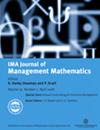使用机器学习对每日新冠肺炎入院人数的概率预测
IF 4.3
3区 工程技术
Q3 MANAGEMENT
引用次数: 0
摘要
准确预测每日新冠肺炎入院人数对于医疗规划人员和决策者在感染高峰期间和周围更好地管理稀缺资源至关重要。许多研究的重点是预测新冠肺炎在国家或全球层面的入院人数。本地化预测至关重要,因为它们允许资源规划的重新分配,但也很稀缺,更难正确。可以使用几种可能的指标来预测新冠肺炎的入院情况。招生的固有可变性需要生成和评估招生的预测分布,而不是只生成一个点预测。在这项研究中,我们提出了一个分位数回归森林(QRF)模型,用于使用多种不同的预测因子,对当地医院信托(3家医院的集合)的每日新冠肺炎入院进行概率预测,最长提前7天。我们使用适当的措施来评估点预测的准确性以及预测分布的准确性。我们提供的证据表明,QRF优于单变量时间序列方法和其他更复杂的基准。我们的研究结果还表明,滞后入院、阳性病例总数、每日检测以及谷歌杂货店和苹果驾驶是最显著的预测因素。最后,我们强调了需要进一步研究的领域。本文章由计算机程序翻译,如有差异,请以英文原文为准。
Probabilistic forecasting of daily COVID-19 admissions using machine learning
Accurate forecasts of daily COVID-19 admissions are critical for healthcare planners and decision-makers to better manage scarce resources during and around infection peaks. Numerous studies have focused on forecasting COVID-19 admissions at the national or global levels. Localised predictions are vital, as they allow for resource planning redistribution, but also scarce and harder to get right. Several possible indicators can be used to predict COVID-19 admissions. The inherent variability in the admissions necessitates the generation and evaluation of the forecast distribution of admissions, as opposed to producing only a point forecast. In this study, we propose a quantile regression forest (QRF) model for probabilistic forecasting of daily COVID-19 admissions for a local hospital trust (aggregation of 3 hospitals), up to 7-days ahead, using a multitude of different predictors. We evaluate point forecast accuracy as well as the accuracy of the forecast distribution using appropriate measures. We provide evidence that QRF outperforms univariate time series methods and other more sophisticated benchmarks. Our findings also show that lagged admissions, total positive cases, daily tests performed, and Google grocery and Apple driving are the most salient predictors. Finally, we highlight areas where further research is needed.
求助全文
通过发布文献求助,成功后即可免费获取论文全文。
去求助
来源期刊

IMA Journal of Management Mathematics
OPERATIONS RESEARCH & MANAGEMENT SCIENCE-MATHEMATICS, INTERDISCIPLINARY APPLICATIONS
CiteScore
4.70
自引率
17.60%
发文量
15
审稿时长
>12 weeks
期刊介绍:
The mission of this quarterly journal is to publish mathematical research of the highest quality, impact and relevance that can be directly utilised or have demonstrable potential to be employed by managers in profit, not-for-profit, third party and governmental/public organisations to improve their practices. Thus the research must be quantitative and of the highest quality if it is to be published in the journal. Furthermore, the outcome of the research must be ultimately useful for managers. The journal also publishes novel meta-analyses of the literature, reviews of the "state-of-the art" in a manner that provides new insight, and genuine applications of mathematics to real-world problems in the form of case studies. The journal welcomes papers dealing with topics in Operational Research and Management Science, Operations Management, Decision Sciences, Transportation Science, Marketing Science, Analytics, and Financial and Risk Modelling.
 求助内容:
求助内容: 应助结果提醒方式:
应助结果提醒方式:


